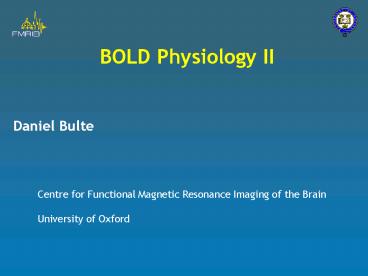BOLD Physiology II PowerPoint PPT Presentation
1 / 28
Title: BOLD Physiology II
1
BOLD Physiology II
Daniel Bulte
Centre for Functional Magnetic Resonance Imaging
of the Brain University of Oxford
2
Neuronal activity to BOLD
3
Correlates of brain activity
electrophysiology
metabolic response
- ? glucose consumption
- ? oxygen consumption
hemodynamic response
- ? blood flow
- ? blood volume
- ? blood oxygenation
4
BOLD FMRI
Basal (resting) state
MRI signal
MRI signal
capillary bed
capillary bed
arterioles
arterioles
venules
venules
CBV
FLOW
HbO2
HbO2
Field gradients
Hbr
Hbr
- normal flow - basal level Hbr - basal CBV -
normal MRI signal
5
BOLD FMRI
Activated state
MRI signal
MRI signal
capillary bed
capillary bed
arterioles
arterioles
venules
venules
CBV
CBV
FLOW
FLOW
HbO2
HbO2
Hbr
Hbr
- increased flow - decreased Hbr (lower field
gradients around vessels ) - increased CBV -
increased MRI signal (from lower field gradients)
6
Dissecting BOLD
SBOLDf(CBV,CBF,CMRO2)
Purer measures of neuronal activity?
Buxton et al. Neuroimage 2004
7
Balloon model of CBV changes
Arteriole
Venule
Capillary Bed
- rCBV increase is a mechanical consequence of CBF
increase - elastic properties of venous bed induce transient
mismatches between CBV and CBF which does not
require uncoupling of CBF and CMRO2
8
CBF CMRO2
CBF
BOLD
- Hoge R et al
9
CMRO2 measurement
Measured BOLD
R2(BOLD) k CBVa dHbb
- k field dependent constant
- CBV cerebral blood volume fraction
- dHb concentration of dHb in blood
- ? theoretical CBV dependence (?1)
- ? theoretical dHb dependence
- ? ? 1.5 (1.5T) Boxerman et al, 1995
- ? ? 1 (gt3T) Ogawa et al, 1993
10
CMRO2 measurement
Substitutions
CMRO2 CBF. OEF . Ca
(Ficks principle)
dHb CMRO2 / CBF
CBV
CBF
(
)
(Grubb et al., 1974)
?
CBV0
CBF0
? 0.38 (steady state value)
ASL measured
11
CMRO2 measurement
Calibrate R20 using a hypercapnia challenge
- A flow increase without increase in CMRO2
12
Calibrated BOLD for measuring CMRO2
CMRO2-CBF coupling slope 2
Calibrated BOLD
- Hoge R et al
13
Factors affecting BOLD signal?
- Physiology
- Cerebral blood flow (baseline and change)
- Metabolic oxygen consumption
- Cerebral blood volume
- Equipment
- Static field strength
- Field homogeneity (e.g. shim dependent T2)
- Pulse sequence
- Gradient vs spin echo
- Echo time, repeat time, flip angle
- Resolution
14
Physiological baseline
- Baseline CBF?,
- But ?CBF ?CMRO2 unchanged (probably) (Brown et al
JCBFM 2003) - BOLD response ? (probably)
Cohen et al JCBFM 2002
15
A bit about baselines
hemodynamic response
16
Implications
- Factors altering baseline state
- Disease
- Sedation
- Anxiety
- Vasoactive medications
- Global and local
- ?CBF (ASL) may be more robust?
17
Investigating NV coupling
18
Investigating NV coupling
- How do pharmacological and physiological
challenges modify the coupling between human
brain activity measured electrophysiologically
and haemodynamically (neurovascular coupling)?
19
Investigating NV coupling
- Advantages
- High temporal and spatial resolution
- Identical mental state
- Single trial analysis
- Spontaneous EEG
20
Noise or signal?
- Noise is unmodelled signal
- Spatially structured
- Temporally structured
- Physiological signal
- Vascular properties
- Neuronal signal
- Resting state networks
- Resting fluctuations
- Stimulus induced deactivation
Separation all haemodynamic
21
Physiological noise
- Motion
- McFLIRT correction
- Cardiac
- Pulsations (aliased)
- Respiratory
- Motion
- B0 shift
RETROICOR correction (Jon Brooks)
22
Physiological signal
- Low frequency haemodynamic oscillations
- Information about vascular properties
- CO2 reactivity
- Autoregulation
- Is it a problem?
- Can we use it?
23
BOLD response to CO2
- CO2 is a potent vasodilator
Hypercapnia CBF, CBV ? ? deoxyHb ? ?
T2 ? ? SBOLD ?
- Previous investigations use sustained
hyper/hypocapnia challenges to investigate
regional sensitivity (1.5T) - e.g. Posse et al. 1997, 2001, Rostrup et al.
2000
24
Spontaneous CO2 fluctuations
Resting PETCO2
PETCO2 power spectrum
- End-tidal CO2 (PETCO2) is a good measure of
arterial CO2 - Fluctuations 0 - 0.05 Hz (Van den Aardweg
Karemaker, 2002) - Overlaps with stimulus frequencies
- Can correlate with stimulation
Wise et al Neuroimage 2004
25
BOLD-CO2 (resting) correlation
r0.5, Z5.5
26
BOLD reactivity to resting CO2
R
L
?SBOLD / mmHg
0
0.35
27
BOLD (CO2) sensitivity and CBV
(PET)
ml/100ml
Ito H. et al., NeuroImage. 2003, 19, 1163-1169
?SBOLD / mmHg
0
0.35
28
Intermission

